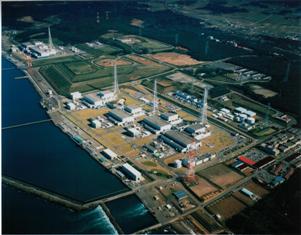 The company's President, Tsunehisa Katsumata, told reporters in Tokyo that the company had sharply cut its forecasts for FY2007. Net income was downwardly revised by some 79% from Y310 billion ($2.6 billion) to Y65 billion ($0.6 billion).
The company's President, Tsunehisa Katsumata, told reporters in Tokyo that the company had sharply cut its forecasts for FY2007. Net income was downwardly revised by some 79% from Y310 billion ($2.6 billion) to Y65 billion ($0.6 billion).The scenario presented by the company did not put a price on repairs required at the site, which are still being assessed. Tepco has previously said that, although the earthquake was more powerful than the plant was designed to cope easily with, no damage was done to major plant components or buildings.
Tepco now predicts the overall capacity factor of its 17nuclear reactors in FY2007 will be 44%, compared to the previousestimate of 72%. The seven units of Kashiwazaki Kariwa output around 8000 MWe, making it the most productive nuclear power plant in the world.
While Tepco's forecast predicts that Kashiwazaki Kariwa could be shut down until the end of the year, Katsumata said: "These are very severe forecasts." However, the company is increasing generation from more expensive fossil-fired power plants to make up the shortfall caused by the extended and unplanned outage, and is also purchasing power from other utilities to meet the demand of its customers.
Tepco also said that if the plant were to stay shut down far into 2008, it could accelerate the construction of gas-fired power plants and even bring some back into service that had been decommissioned.
The extent of shaking within the plant has also been detailed by Tepco spokesmen. Although the plant was designed to withstand an earthquake of up to 6.5 on the Richter scale in accordance with Japanese regulations, it was struck by one of 6.8 centred just 16 km away. The maximum ground acceleration recorded at unit 1 was 680 gal, compared to a design value of 273 gal.
The purpose of the design value is to set a limit for engineers up to which the plant should be able to shut down safely and be restarted relatively quickly following a thorough check. A second value of up to 450 gal was specified, up to which the plant should shut down safely and remain safe, even if damage is done to parts of the plant. In the turbine building of unit 3, shaking reached 2058 gal.
The principal effects of the violent shaking were that some mildly radioactive water was shaken from used nuclear fuel cooling ponds, many barrels of low-level radioactive waste were displaced and an external electrical transformer failed and caught fire. The plant grounds were also hit hard, suffering widespread soil liquefaction.
Further information
Tokyo Electric Power Company (Tepco)
WNA's Nuclear Power in Japan information paper
WNA's Nuclear Power Plants and Earthquakes information paper
WNA's Earthquakes and Nuclear Safety microsite
WNN: Tepco lists earthquake effects
WNN: Tepco battered by media storm
WNN: Kashiwazaki Kariwa nuclear units shut down on earthquake





_91467.jpg)
_47120.jpg)
_16439.jpg)





